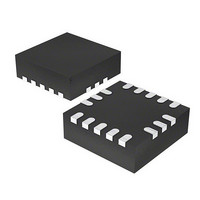LIS3DHTR STMicroelectronics, LIS3DHTR Datasheet - Page 15

LIS3DHTR
Manufacturer Part Number
LIS3DHTR
Description
ACCELEROMETER 3AXIS MEMS 16-LGA
Manufacturer
STMicroelectronics
Datasheet
1.LIS3DHTR.pdf
(42 pages)
Specifications of LIS3DHTR
Lead Free Status / RoHS Status
Lead free / RoHS Compliant
Other names
497-10613-2
Available stocks
Company
Part Number
Manufacturer
Quantity
Price
Part Number:
LIS3DHTR
Manufacturer:
ST
Quantity:
20 000
LIS3DH
3
3.1
3.1.1
3.1.2
3.2
3.2.1
Terminology and functionality
Terminology
Sensitivity
Sensitivity describes the gain of the sensor and can be determined e.g. by applying 1 g
acceleration to it. As the sensor can measure DC accelerations this can be done easily by
pointing the axis of interest towards the center of the earth, noting the output value, rotating
the sensor by 180 degrees (pointing to the sky) and noting the output value again. By doing
so, ±1 g acceleration is applied to the sensor. Subtracting the larger output value from the
smaller one, and dividing the result by 2, leads to the actual sensitivity of the sensor. This
value changes very little over temperature and also time. The sensitivity tolerance describes
the range of Sensitivities of a large population of sensors.
Zero-g level
Zero-g level offset (TyOff) describes the deviation of an actual output signal from the ideal
output signal if no acceleration is present. A sensor in a steady state on a horizontal surface
measure 0 g in X axis and 0 g in Y axis whereas the Z axis measure 1 g. The output is
ideally in the middle of the dynamic range of the sensor (content of OUT registers 00h, data
expressed as 2’s complement number). A deviation from ideal value in this case is called
Zero-g offset. Offset is to some extent a result of stress to MEMS sensor and therefore the
offset can slightly change after mounting the sensor onto a printed circuit board or exposing
it to extensive mechanical stress. Offset changes little over temperature, see “Zero-g level
change vs. temperature”. The Zero-g level tolerance (TyOff) describes the standard
deviation of the range of Zero-g levels of a population of sensors.
Functionality
Normal mode, low power mode
LIS3DH provides two different operating modes respectively reported as normal mode and
low power mode. While normal mode guarantees high resolution, low power mode reduces
further the current consumption.
The table below reported summarizes how to select the operating mode.
Table 9.
CTRL_REG1[3]
(LPen bit)
1
0
Operating mode selection
CTRL_REG4[3]
(HR bit)
0
1
Doc ID 17530 Rev 1
Low power mode
Normal mode
Operating mode
Terminology and functionality
15/42













